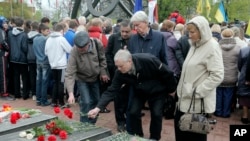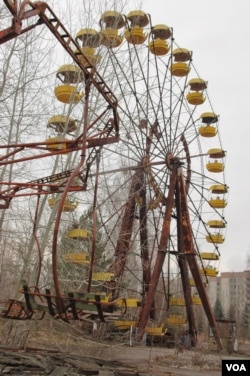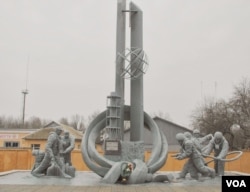Tuesday marks the 30th anniversary of the Chernobyl nuclear disaster, when an explosion at the power plant near the town contaminated a wide area and sent radiation clouds across the globe.
During the catastrophe, two people died immediately, while 29 more died within weeks. It is estimated thousands more have died from cancers and other illnesses in the ensuing years.
More than 200 tons of uranium are still inside the reactor site, fueling fears that new radiation leaks could occur in the area, which is already considered to be unsafe for at least the next century.
International donors on Monday pledged an additional $99 million in aid toward completing a newer, safer fuel storage facility for Chernobyl.
The reactor is now a huge construction site, with cranes towering over the remains of the power station. The radiation levels still set off danger warnings, three decades after the explosion.
Around 7,000 workers are still decommissioning the site. The staff is large so that the workers can limit their radiation exposure.
They are not in danger, says Volodymyr Yegerov, a nuclear safety expert with Ukraine’s National Academy of Sciences, who also acted as VOA’s guide on a tour of the site.
“If you comply with the rules of radiation safety, it is absolutely safe,” he said. “The dose of radiation one gets here is a little bit higher than in Kyiv, for instance.”
Human error and poor reactor design have been blamed for the accident in what was then the Soviet Union. During a shutdown test in the early hours of April 26, 1986, a steam explosion blew the roof off reactor 4. Blocks of super-heated graphite rained down on the site and huge amounts of radioactive particles were released into the air.
Then, as now, the firefighters and so-called "liquidators" who first tackled the blaze are lauded as heroes. At least 28 of them died from acute radiation sickness.
Archbishop Theodore Bubnyuk of the Ukrainian Orthodox Church conducted a religious ceremony this week to honor the victims.
“It is undoubtedly a great tragedy, by which many individuals were affected,” he told VOA. “We are still losing many people because of it. It is a great pain, a massive wound for our country and our nation.”
WATCH: Chernobyl: World's Most Exotic Tourist Destination?
The 30th anniversary is significant as the so-called concrete "sarcophagus" that was hastily built over the reactor has a three-decade life span.
A giant arch is designed to replace it and is nearing completion. Officially called the "New Safe Confinement," it has taken six years and around $2 billion to build. Sometime in 2017, the structure -- which is tall enough to contain the cathedrals of St. Paul in London or Notre Dame in Paris -- will be moved on rails over the reactor.
“It will not only serve as a shield from radiation, but will also allow dismantling of the old radioactive structures. First of all, the old concrete sarcophagus, which is not in good condition. As a result of these works, in 100 years there is to be a green lawn here,” said Yegerov.
It is an optimistic vision, but the area won’t be habitable for tens of thousands of years.
The 2,600 square-kilometer exclusion zone is an under-used resource, said environmental consultant Roman Zinchenko, who has visions of turning the area into a vast green energy site.
“This is the site where both we humans, and nature, heal the wounds. And the revival of this place can be a very important lesson for not just Ukraine, but all humanity.”
Since 2011, tourists have been allowed to visit Chernobyl. Among the most popular sites is the so-called "Russian Woodpecker," a vast radar system designed to protect then-Soviet-controlled Kyiv from attack.
Much of the Chernobyl exclusion zone provides a snapshot of Cold War tensions, frozen in time in 1986.
The world has changed much in the intervening three decades. Some argue it is time to seek a new future for Chernobyl.
Marissa Melton in Washington contributed to this report.


